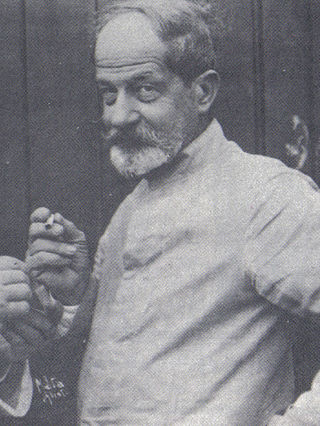
Antônio Diogo da Silva Parreiras was a Brazilian painter, designer and illustrator.

Victor Meirelles de Lima was a Brazilian painter and teacher who is best known for his works relating to his nation's culture and history. From humble origins, his talent was soon recognized, being admitted as a student at the Imperial Academy of Fine Arts. He specialized in the genre of history painting, and upon winning the Academy's Foreign Travel Award, he spent several years training in Europe. There he painted his best-known work, Primeira Missa no Brasil. Returning to Brazil, he became one of emperor Pedro II's favorite painters, joining the monarch's patronage program and aligning himself with his proposal to renew the image of Brazil through the creation of visual symbols of its history.

The creation of art in the geographic area now known as Brazil begins with the earliest records of its human habitation. The original inhabitants of the land, pre-Columbian Indigenous or Natives peoples, produced various forms of art; specific cultures like the Marajoara left sophisticated painted pottery. This area was colonized by Portugal in the 16th century and given the modern name of Brazil. Brazilian art is most commonly used as an umbrella term for art created in this region post Portuguese colonization.

Escola de Belas Artes is one of the centers of the Federal University of Rio de Janeiro and dates back to colonial times.

Rodolfo Amoedo was a Brazilian painter, designer and decorator.

Eliseu Visconti, born Eliseo d'Angelo Visconti was an Italian-born Brazilian painter, cartoonist, and teacher. He is considered one of the very few impressionist painters of Brazil. He is considered the initiator of the art nouveau in Brazil.

The roots of Brazilian sculpture have been traced back to the late 16th century, emerging soon after the first settlements in the newly discovered land. Through the following century, most of the sculpture in Brazil was brought from Portugal and displayed Baroque features. The Baroque style would flourish within the religious culture of the country and would remain predominant until the first decades of the 19th century. In the 19th century, sculptural activity decreased, but it later revived when both the government and the public took a new interest in the art. Modernism fomented a period of intense research into a new language of sculpture, with great achievements, and the contemporary sculpture of Brazil enjoys worldwide respect.

João Zeferino da Costa was a Brazilian painter and designer.

Lucílio de Albuquerque was a Brazilian painter, designer and art professor.

Emil Bauch was a German painter, lithographer and teacher who came to reside in the city of Rio de Janeiro. He painted panoramic city scenes and portraits, as well as some views of Recife and Salvador. His landscapes are conspicuous by his close observation of all the details and the intense variety of motifs of his palette. His works have all but disappeared in the shadow of paintings created by other artists during the second half of the nineteenth century in Brazil.

Henrique Bernardelli was a Brazilian painter.

The Imperial Academy of Fine Arts was an institution of higher learning in the arts in Rio de Janeiro, Brazil, established by King João VI. Despite facing many initial difficulties, the Academy was established and took its place at the forefront of Brazilian arts education in the second half of the nineteenth century. The Academy became the center of the diffusion of new aesthetic trends and the teaching of modern artistic techniques. It eventually became one of the principal arts institutions under the patronage of Emperor Dom Pedro II. With the Proclamation of the Republic, it became known as the National School of Fine Arts. It became extinct as an independent institution in 1931, when it was absorbed by the Federal University of Rio de Janeiro (UFRJ) and became known as the UFRJ School of Fine Arts, which still operates today.

Antônio Firmino Monteiro was an Afro-Brazilian painter.

Giovanni Battista Felice Castagneto, or João Batista Castagneto, was an Italo-Brazilian landscape and seascape painter.

Modesto Brocos y Gómez was a Spanish-Brazilian painter and engraver.

Francisco Pedro do Amaral was a Brazilian painter, designer, scenographer and gilder.

João Timóteo da Costa was an Afro-Brazilian painter and decorative artist.

Augusto Bracet was a Brazilian painter, drawer and professor.

The Sociedade Brasileira de Belas Artes SBBA is a public benefit entity that aims to promote and disseminate plastic arts. The SBBA is located in the historic building of the 18th century Solar do Marques do Lavradio in downtown Rio de Janeiro, in the Lapa neighborhood, at Rua do Lavradio, nº 84.

José Maria Oscar Rodolfo Bernardelli y Thierry was a Mexican-born Brazilian sculptor and art professor, of Italian ancestry.


























